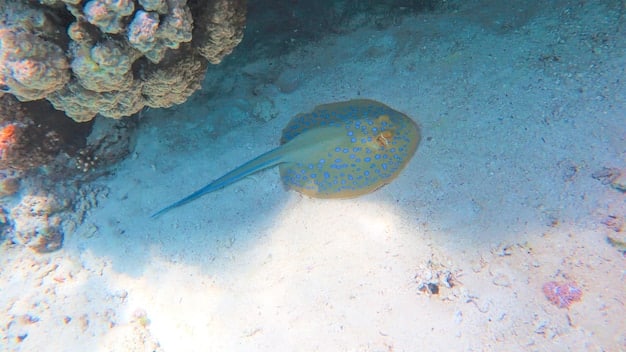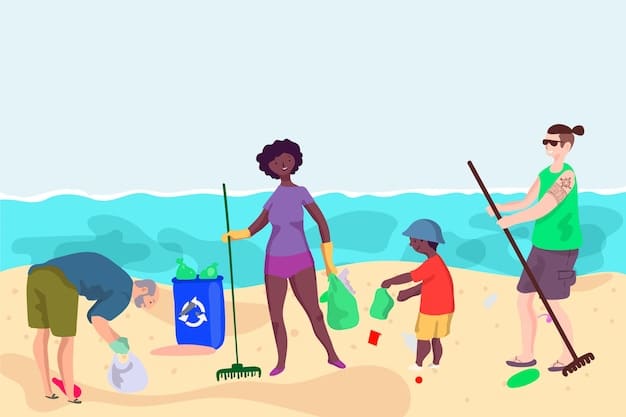Reduce Carbon Footprint: Protect Marine Life in the US

Individuals in the US can significantly reduce their carbon footprint to protect marine life by adopting sustainable consumption habits, advocating for policy changes, and supporting conservation efforts, mitigating ocean acidification and habitat degradation.
The health of our oceans is intricately linked to the choices we make every day. Understanding how can individuals reduce their carbon footprint to protect marine life in the US is not merely an environmental plea; it’s a call to action for the preservation of vital ecosystems and the diverse species they harbor.
Understanding the carbon footprint and its impact on marine life
Our carbon footprint represents the total greenhouse gas emissions caused directly and indirectly by an individual, organization, event, or product. These emissions, primarily carbon dioxide, are a major driver of climate change. For marine ecosystems, the consequences are particularly dire, leading to significant alterations in ocean chemistry and habitats.
The increase in atmospheric CO2, largely from human activities, is absorbed by the oceans, leading to ocean acidification. This process reduces the availability of carbonate ions, essential building blocks for shellfish, corals, and other calcifying organisms. Their ability to form shells and skeletons is compromised, threatening entire food webs.
The science of ocean acidification
Ocean acidification is often called “the other CO2 problem.” As carbon dioxide dissolves in seawater, it forms carbonic acid, which then releases hydrogen ions, making the water more acidic. This shift in pH affects numerous marine species, from microscopic plankton to large fish. The implications extend beyond individual organisms, impacting ecosystems on a global scale.
- Coral bleaching: Acidified waters stress corals, leading to the expulsion of symbiotic algae and subsequent bleaching, often resulting in coral death.
- Shell-forming organisms: Oysters, clams, sea urchins, and pteropods (sea snails, a vital food source) struggle to build and maintain their protective shells.
- Fish behavior: Studies suggest that increased acidity can impair the ability of some fish species to navigate, locate prey, and avoid predators.
- Food web disruption: The decline of key species at the base of the marine food web can have cascading effects on predators and the overall health of the ecosystem.
Beyond acidification, rising ocean temperatures, also linked to carbon emissions, contribute to marine heatwaves, sea-level rise, and altered ocean currents. These changes stress marine life, pushing species beyond their tolerance limits and leading to mass migrations or extinctions. Coastal communities face increased risks from storm surges and erosion as sea levels rise.
The intricate balance of marine ecosystems is highly sensitive to these changes. From the smallest phytoplankton producing much of the Earth’s oxygen to the largest whales, every organism plays a crucial role. Disturbing this balance through excessive carbon emissions threatens not only marine biodiversity but also the critical services oceans provide, such as climate regulation, food security, and economic opportunities.
Sustainable energy choices: powering a greener future for oceans
One of the most impactful ways individuals can reduce their carbon footprint is by transitioning to sustainable energy sources. The energy sector is a primary contributor to greenhouse gas emissions, and shifting away from fossil fuels can dramatically lessen our environmental impact, benefiting marine life directly.
At a household level, this means evaluating energy consumption and seeking cleaner alternatives. It’s about more than just turning off lights; it involves a deeper look into where our energy comes from and how efficiently we use it. Making these changes can seem daunting, but even small steps can accumulate into significant positive impacts.
Adopting renewable energy at home
For many homeowners, exploring renewable energy options can be a game-changer. Solar panels, for example, convert sunlight into electricity, significantly reducing reliance on fossil fuel-derived power. While the initial investment might be considerable, long-term savings and environmental benefits are substantial.
- Solar panel installation: Investigate federal and state incentives or rebates for solar energy systems, as these can make installation more affordable.
- Community solar programs: If rooftop solar isn’t feasible, consider subscribing to a community solar project, which allows you to support renewable energy without on-site installation.
- Green energy providers: Switch to an electricity provider that sources its energy from renewables, if available in your area. This ensures your power comes from wind, solar, or hydroelectric sources.
Beyond active renewable energy generation, improving energy efficiency within the home also plays a critical role. Simple upgrades and behavioral changes can reduce overall energy demand. This includes better insulation, energy-efficient appliances, and mindful consumption habits.
For those living in apartments or rented properties where large-scale changes might not be possible, focusing on energy efficiency is still highly effective. Every kilowatt-hour saved means less demand on carbon-intensive power grids, directly contributing to a healthier marine environment by reducing the emissions that fuel ocean acidification and warming.
Reducing consumption and waste: minimizing our ecological footprint
Our consumption patterns directly influence our carbon footprint. The production, transport, and disposal of goods all require energy and generate emissions. By adopting a more mindful approach to consumption and actively reducing waste, individuals can significantly lessen their environmental impact and contribute to marine protection.
This approach emphasizes quality over quantity, durability over disposability, and a deeper understanding of the lifecycle of the products we use. It moves beyond just recycling and embraces a holistic view of resource management, aiming to decrease demand for new materials and the energy intensive processes that accompany their creation.

Embracing the “reduce, reuse, recycle” hierarchy
While recycling is well-known, the full “reduce, reuse, recycle” hierarchy prioritizes reduction and reuse as the most effective strategies. Reducing consumption means buying less, choosing durable products, and avoiding unnecessary packaging. Reusing items extends their life, preventing them from becoming waste.
- Conscious purchasing: Before buying, consider if you truly need an item. Opt for products with minimal packaging, made from recycled materials, or designed for longevity.
- Reusable alternatives: Replace single-use items (plastic bags, water bottles, coffee cups, straws) with durable, reusable options. This directly reduces plastic pollution, a major threat to marine life.
- Donating and repairing: Instead of discarding, donate usable items or repair broken ones. This gives products a second life and reduces the demand for new manufacturing.
The waste we generate, particularly plastic waste, often finds its way into marine environments, causing immense harm to wildlife through entanglement and ingestion. By minimizing waste, we directly reduce this threat. Composting organic waste also reduces methane emissions from landfills, further lessening our carbon footprint.
Embracing a circular economy mindset, where products and materials are kept in use for as long as possible, is key. This approach contrasts sharply with the traditional linear “take, make, dispose” model. Every small decision to reduce, reuse, or repair contributes to a broader cultural shift towards sustainability, benefiting oceans by curbing pollution and emissions.
Sustainable transportation: navigating towards cleaner seas
Transportation is a major source of greenhouse gas emissions, particularly in countries like the US, where personal vehicles are prevalent. Adopting more sustainable modes of transport can significantly lower an individual’s carbon footprint, contributing to healthier air and, consequently, healthier oceans by reducing atmospheric carbon.
This shift involves evaluating daily commutes, long-distance travel, and even leisure activities. It’s about prioritizing efficiency, minimizing reliance on fossil fuels, and investing in infrastructures that support low-carbon mobility. Even small changes in routine can collectively lead to substantial environmental improvements.
Greener commuting and travel habits
For daily commutes, exploring alternatives to single-occupancy vehicles can have a profound impact. Public transportation, carpooling, cycling, and walking are all excellent ways to reduce emissions and often offer health benefits as well. Planning ahead can make these options more feasible and convenient.
- Public transit utilization: Maximize use of buses, trains, and subways for daily commutes and errands. This significantly reduces individual vehicle emissions.
- Carpooling/ridesharing: Share rides with colleagues or friends to reduce the number of vehicles on the road, decreasing overall emissions.
- Active transportation: For shorter distances, consider walking or cycling. These modes produce zero emissions and offer health advantages.
- Vehicle efficiency: If a personal car is necessary, opt for fuel-efficient models, hybrids, or electric vehicles (EVs). Regular vehicle maintenance also ensures optimal fuel economy.
For longer journeys, air travel and long-distance driving are particularly carbon-intensive. While eliminating them entirely may not be practical for everyone, making conscious choices about travel frequency and exploring less impactful alternatives can still make a difference. Opting for train travel over flying, for instance, can significantly reduce per-person emissions.
Supporting policies that invest in robust public transportation networks, safe cycling infrastructure, and EV charging stations also amplifies individual efforts. By advocating for these changes, individuals contribute to a systemic shift towards a low-carbon transport system, which is crucial for protecting marine environments from climate change impacts.
Advocacy and community involvement: amplifying individual impact
While individual actions are vital, their impact can be significantly amplified through collective advocacy and community involvement. Engaging with local and national initiatives, supporting environmental policies, and educating others are powerful ways to drive systemic change, which is essential for protecting marine life on a larger scale.
This means moving beyond personal lifestyle adjustments to actively participating in the broader conservation movement. It involves lending your voice to causes that matter, supporting organizations doing crucial work, and encouraging others to join the effort. Collective action can exert pressure on policymakers and corporations to adopt more sustainable practices.

Engaging in marine conservation efforts
There are numerous avenues for individuals to get involved in marine conservation, ranging from local clean-ups to supporting legislative changes. Every form of engagement, no matter how small, contributes to the overall goal of protecting our oceans from carbon-related threats and pollution.
- Support conservation organizations: Donate to or volunteer with reputable organizations focused on marine conservation and climate action. Their work often includes research, policy advocacy, and on-the-ground restoration efforts.
- Vote for environmental policies: Support political candidates and policies that prioritize climate action, renewable energy, ocean protection, and sustainable resource management.
- Participate in clean-ups: Join local beach clean-ups or river clean-ups. Reducing plastic and debris prevents marine pollution, which exacerbates the stress on marine ecosystems already facing climate change.
- Raise awareness: Educate family, friends, and your community about the impacts of carbon emissions on marine life and how they can contribute to solutions. Share credible information and inspire positive change.
Advocating for sustainable fisheries, regulating industrial pollution, and protecting marine protected areas are also critical. These larger-scale issues require collective pressure to ensure that governments and industries adopt practices that safeguard marine biodiversity and health. Individuals, by adding their voice to these calls, become powerful agents of change.
Community involvement can also take the form of supporting local sustainable businesses, reducing reliance on unsustainable products, and promoting responsible tourism that minimizes environmental impact. By embedding sustainable values within social circles and local economies, individuals help create a culture that inherently values and protects marine life.
Dietary choices and their marine implications: eating for the ocean
The food we consume, particularly how it is produced and transported, significantly contributes to our carbon footprint. Our dietary choices have direct and indirect impacts on marine ecosystems, from greenhouse gas emissions associated with agriculture to the health of aquatic environments. Making more sustainable food choices is another powerful way for individuals to protect marine life.
This involves understanding the environmental costs of different food groups and opting for alternatives that have a lower carbon footprint. It is about a conscious shift towards reducing demand for carbon-intensive products and supporting food systems that are more environmentally benign.
Adopting a marine-friendly diet
Reducing consumption of certain foods, especially those with high carbon footprints, can yield substantial environmental benefits. Meat and dairy production, for instance, are significant contributors to greenhouse gas emissions due to methane from livestock and the energy required for their feed and processing.
- Reduce meat and dairy consumption: Incorporate more plant-based meals into your diet. Legumes, grains, fruits, and vegetables generally have a much lower carbon footprint than animal products.
- Choose sustainable seafood: If consuming seafood, opt for sustainably sourced options certified by reputable organizations. Avoid species that are overfished or caught using destructive methods (like bottom trawling, which damages marine habitats).
- Support local and seasonal produce: Buying local and seasonal foods reduces the energy needed for transportation and storage, lowering your food’s overall carbon footprint.
- Minimize food waste: Plan meals, store food properly, and compost scraps to reduce food waste, which contributes to methane emissions in landfills.
The production of fertilizers and pesticides used in conventional agriculture can also lead to nutrient run-off into coastal waters, causing algal blooms (eutrophication). These blooms deplete oxygen, creating “dead zones” that devastate marine life. By supporting organic farming or reducing demand for industrially produced crops, individuals indirectly help protect marine ecosystems.
Every meal presents an opportunity to make a choice that benefits the planet. By shifting towards more plant-rich diets and being mindful of the origins and methods of food production, individuals can significantly decrease their dietary carbon footprint, thereby protecting our oceans from various forms of environmental degradation.
Innovative solutions and future outlook: pioneering a sustainable marine future
While individual actions are foundational, the scale of the climate crisis demands innovative solutions and a forward-looking approach. Investing in research, technological advancements, and policy frameworks that support carbon reduction and marine conservation offers a powerful path toward a sustainable future. Individuals can contribute by supporting these broader initiatives.
This includes advocating for and investing in technologies that actively remove carbon from the atmosphere, promote sustainable aquaculture, and enhance our understanding of marine ecosystems. It’s about leveraging human ingenuity to solve complex environmental challenges and create a resilient future for our oceans.
Supporting cutting-edge marine protection
Emerging technologies and scientific advancements hold immense promise for addressing the impacts of climate change on marine life. From advanced carbon capture technologies to innovative aquaculture practices, these solutions require public and private support to scale effectively.
- Direct air capture (DAC) technologies: Support research and development into technologies that can directly remove CO2 from the atmosphere, which can then be stored or utilized.
- Blue carbon initiatives: Advocate for the protection and restoration of coastal ecosystems like mangroves, salt marshes, and seagrass beds, which are highly efficient at sequestering carbon but are often overlooked.
- Sustainable aquaculture and mariculture: Support practices that responsibly farm marine organisms, reducing pressure on wild fish stocks and minimizing environmental impacts.
- Marine protected areas (MPAs) expansion: Advocate for the establishment and effective management of more MPAs, which protect biodiversity, allow ecosystems to recover, and enhance their resilience to climate change.
Beyond technology, fostering a deeper connection between people and the ocean through education and citizen science programs is crucial. When individuals understand the intrinsic value and fragility of marine ecosystems, they are more likely to become advocates for their protection. Participation in such programs also contributes valuable data for scientific research and conservation efforts.
The future of marine life hinges not only on reducing our carbon footprint but also on actively developing and implementing solutions that mend past damages and build future resilience. By engaging with and supporting these innovative approaches, individuals become part of a larger movement that champions the health and vitality of our global oceans for generations to come.
| Key Point | Brief Description |
|---|---|
| ☀️ Sustainable Energy | Transition to renewables and improve home energy efficiency to reduce emissions. |
| 🛒 Conscious Consumption | Reduce, reuse, and recycle to lessen waste and demand for new, carbon-intensive products. |
| 🚲 Green Transport | Use public transport, cycle, or choose efficient vehicles to lower transportation emissions. |
| 🌱 Sustainable Diet | Reduce meat/dairy, choose sustainable seafood, and minimize food waste for a lower footprint. |
Frequently asked questions
▼
A carbon footprint represents the total greenhouse gas emissions an individual causes. These emissions, primarily CO2, increase ocean acidification and warming, directly harming marine life by bleaching corals, impacting shell formation, and disrupting ecosystems.
▼
Most energy generation relies on fossil fuels, releasing CO2. By switching to renewable energy sources like solar or choosing green energy providers, you decrease demand for carbon-intensive power, which lessens atmospheric CO2 absorbed by oceans, benefiting marine health.
▼
Yes. Producing certain foods, especially meat and dairy, involves high carbon emissions. Shifting towards more plant-based diets, choosing sustainable seafood, and reducing food waste significantly lowers your carbon footprint and reduces agricultural runoff that harms coastal waters.
▼
Transportation is a major emission source. Opting for public transit, cycling, walking, or electric vehicles instead of traditional cars reduces greenhouse gases. This directly lowers atmospheric carbon, thereby mitigating ocean acidification and warming impacts on marine ecosystems.
▼
Beyond individual efforts, engage in advocacy and community involvement. Support conservation organizations, vote for environmental policies, participate in beach clean-ups, and educate others about marine protection. Collective action amplifies impact and drives systemic change for healthier oceans.
Conclusion
Understanding how can individuals reduce their carbon footprint to protect marine life in the US reveals a clear path forward—one that intertwines personal responsibility with collective action. From adopting sustainable energy and mindful consumption to making greener dietary and transportation choices, every decision holds weight. Our oceans, vital for planetary health and human well-being, depend on these conscious shifts. By uniting individual efforts with broader advocacy and support for innovative solutions, we can foster a resilient marine future, ensuring the vibrancy of our underwater world for generations to come. The time for decisive action is now, and the power to make a difference rests with each of us.





